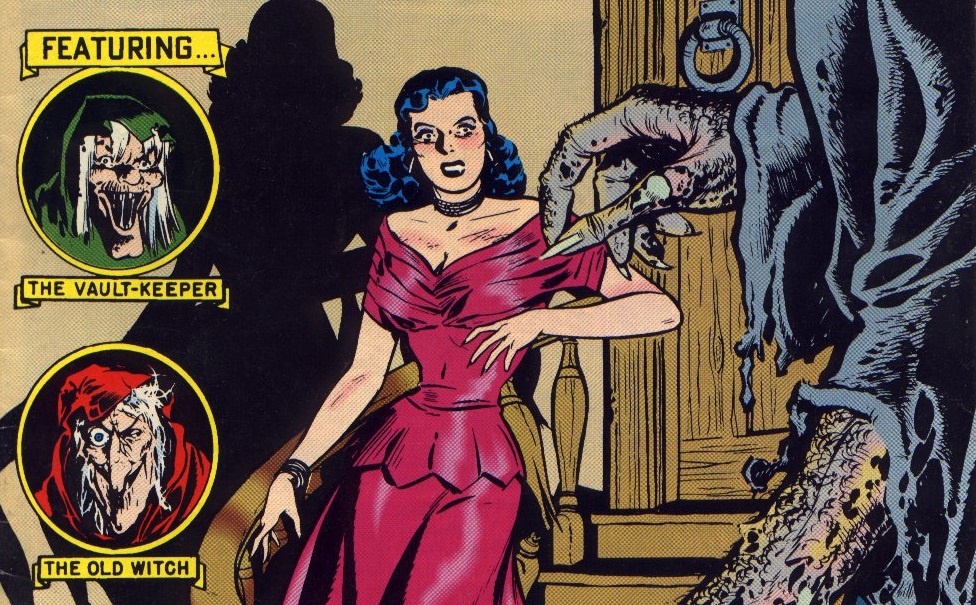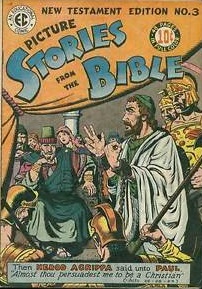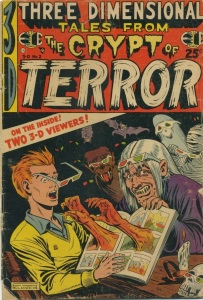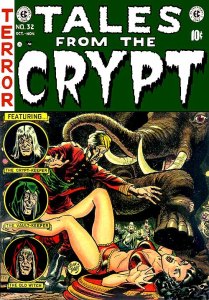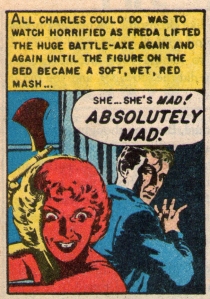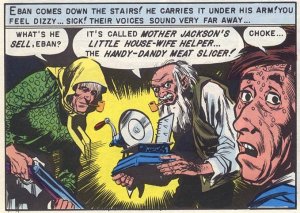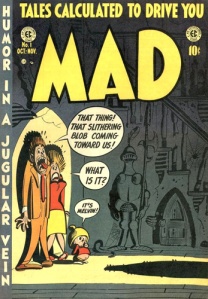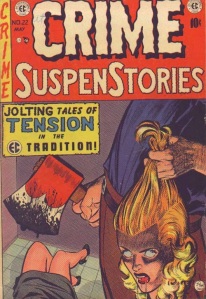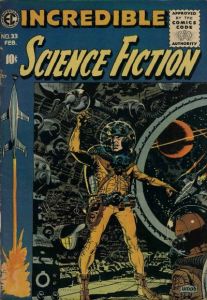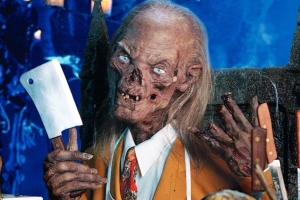This is an expanded and up-dated version of a paper originally presented at Watching the Media, a symposium on censorship and culture held at Edge Hill University in 2011.
Before Elvis there were EC comics. In the history of horror and censorship, EC comics are a legend: cool, cult objects from the shady, esoteric side of post-war American popular culture, before the King broke through on Milton Berle and Ed Sullivan, like the fetish photographs of Bettie Page, the Ed Gein murders, wild rockabilly, and the Mad Daddy on WHKK. EC comics are the ghostly Other and the evil twin of Disney and Golden Age superheroes; subversive, sexy, adult, and darkly humorous. The company name has become a critical synonym for a specific style of American Gothic in film, fiction, and graphic art, and, in genre orthodoxy, EC is a major symbol of the struggle between artist and censor, with innovative writer/publisher William M. Gaines frequently cast as the hero against the McCarthy-era fundamentalism of the psychiatrist Dr. Frederic Wertham, author of The Seduction of the Innocent: The Influence of Comic Books on Today’s Youth. But what exactly is the ‘EC style’ to which genre critics still casually elude? Where did EC comics come from? Where did they go?
After the Second World War, the marriage of Romantic literature, Victorian theatre, and Expressionist art that had defined Hollywood Gothic and the horror genre for a generation effectively ended when Abbot and Costello met Frankenstein in 1948. (They also met Boris Karloff the following year, the Invisible Man in 1951, and Dr. Jekyll and Mr. Hyde in 1953.) Post-war horror films moved away from nineteenth century literary archetypes – such as Universal Pictures’ Frankenstein and Dracula cycles – and towards pulp fiction and popular culture. The target audience, meanwhile, became more juvenile, as corporate America invented the teenage consumer.
The Hollywood Studio System had also changed considerably after the war, ‘declining to a state of panic,’ wrote Thomas F. Brady in the New York Times in 1949, ‘from the 1946 peak of excess profits and lavish waste’ (Brady: 1949). Hollywood Babylon had fallen, after a Supreme Court anti-trust ruling broke the big studios’ stranglehold on distribution in 1948, the same year that commercial network television came into its own, when NBC transferred Milton Berle and the Texaco Star Theatre show from radio to the small screen. Savage cost cutting meant that major studios abandoned second feature genre productions, creating a niche for very low-budget independent companies with extravagant names like ‘Golden Gate’ and ‘Galaxy’ but which, in the words of film historian Denis Gifford, ‘could seldom afford a permanent address’ (Gifford: 1991, 24). Edward D. Wood was working on The Streets of Laredo by 1948, but he was already thinking about Bride of the Atom.
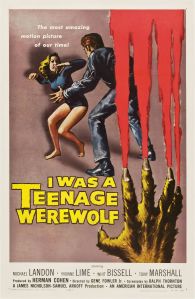 As Hollywood horror shook off the influences of Romantic literature and visual Modernism that had characterised the films of Paul Leni and James Whale in the 1920s and 30s, a distinctive post-war gothic style was emerging in the United States, one that reflected the victorious, optimistic new consumer culture on the one hand, and, on the other, the Cold War anxiety that followed the first Soviet nuclear tests of 1949 and the Korean War of 1950. Like the new medium of television, post-war horror was generically hybrid, contemporary, kitsch and comedic. Early examples of this new aesthetic include PRC/Eagle-Lion’s Devil on Wheels (1947, teens in torment/hot-rod horror), Lippert Picture’s Rocketship X-M (1950, the origin of ‘atomic cinema’), and Realart Picture’s Bride of the Gorilla (1951, ‘PRIMITIVE! PASSIONATE!’ promised the poster, ‘Nothing like it ever before!’).
As Hollywood horror shook off the influences of Romantic literature and visual Modernism that had characterised the films of Paul Leni and James Whale in the 1920s and 30s, a distinctive post-war gothic style was emerging in the United States, one that reflected the victorious, optimistic new consumer culture on the one hand, and, on the other, the Cold War anxiety that followed the first Soviet nuclear tests of 1949 and the Korean War of 1950. Like the new medium of television, post-war horror was generically hybrid, contemporary, kitsch and comedic. Early examples of this new aesthetic include PRC/Eagle-Lion’s Devil on Wheels (1947, teens in torment/hot-rod horror), Lippert Picture’s Rocketship X-M (1950, the origin of ‘atomic cinema’), and Realart Picture’s Bride of the Gorilla (1951, ‘PRIMITIVE! PASSIONATE!’ promised the poster, ‘Nothing like it ever before!’).
The relatively new medium of the comic book also stepped out of the darkness in the 40s, with DC’s gothic/noir vigilante Batman acquiring a teenage ward and a comedy butler, fighting crime during the day, and handing the bad guys over to the police. In his early days he had killed them himself. Robin was intended to play Watson to Bruce Wayne’s Sherlock Holmes, and to make the character safer; more like Superman than Batman’s kinky pulp inspiration, the Shadow. The introduction of a ‘kid sidekick’ doubled sales virtually overnight, re-aligning Batman with a younger market and away from his adult origins. All the Golden Age DC and Atlas (later Marvel) superheroes had contributed to the war effort, selling war bonds and fighting the Axis in simple and gaudy propaganda. Superman – an immigrant himself – was the perfect symbol of American inclusivity, and although his principles were originally socialist, after Pearl Harbour he really did fight for ‘Truth, Justice and the American way of life’ (1). Post-war comic narratives remained morally and politically simplistic, retaining a slightly strained sense of innocence, and implicitly targeted at kids. Superhero comics sold alongside Disney publications on the newsstands, away from the pulp fiction and glamour magazines on the ‘adult’ shelves.
The cheap, colourful pulp magazines (the successors to the penny dreadful), that had dominated the popular short story market since the late-nineteenth century had also had their day. Once as alluring as a femme fatale and thick as a baby’s arm, the paper shortages of the Second World War had reduced these ragged giants to a digest format, and titles like Spicy Mystery, Weird Tales, Amazing Stories and The Shadow were merging with paperback novels and passing away, as the number of comic books – that they undoubtedly inspired – grew. This separation of popular literature (pulps to paperbacks) from illustrated stories (pulps to comic books) further emphasised the line of perceived demarcation between fiction aimed at adults (which was text-based) and fiction aimed at children (which was graphic).
William M. Gaines, heir to Max Gaines’ modest publishing company, EC Comics, liked to put it about that his father had invented the comic book. This wasn’t exactly true – the form can be traced back to the previous century – but Max Gaines was certainly a pioneer. His first company, All-American Publications, was an affiliate of National Allied Publications (later DC Comics), and was creatively responsible for the Golden Age superheroes the Atom, the Flash, the Green Lantern, and Wonder Woman – essentially the entire DC stable less Superman and Batman. (Doctor Mid-Nite and the Gay Ghost did not, however, make it into comic book history.) Max Gaines believed that comic books were an educational medium, and when he left DC he took his title Picture Stories from the Bible with him, starting ‘Educational Comics’ in 1944 with a view to selling ‘Picture Stories’ about Christianity, history and science to schools and churches. He also added a few ‘funny animal’ title for kids, such as Animal Fables and Tiny Tot Comics (starring Freddie the Firefly and Willie the Weasel), created a new super-heroine, ‘Moon Girl,’ and published an essay analysing the medium entitled ‘Narrative Illustration.’ He died saving a child in a boating accident in 1947, his son, William (‘Bill’), inheriting the family business.
Willie the Weasel, and Picture Stories from The Bible, Science, and American and World History died with Max. Bill set about boosting sales by astutely excising edification as a business strategy and re-branding as ‘Entertaining Comics,’ hiring fellow Air Force veteran Al Feldstein as an artist. Moon Girl was re-launched as Moon Girl Fights Crime! alongside new titles Crime Patrol and War Against Crime! (There were also a trio of western titles, Gunfighter, Saddle Romances and Saddle Justice.) Feldstein was soon editing seven EC titles, and writing more than illustrating. Like the Expressionist directors whose Great War experiences bled into their movies (such as F.W. Murnau and James Whale), Feldstein applied an ex-serviceman’s gallows humour to his stories, deliberately writing for a young adult male audience in the pulp tradition, having observed soldiers reading superhero comics during the war (qtd. in Mann, 1990). Neither was he averse to knocking off a pulp plot to make a deadline. Hard-boiled archetypes proliferate in the stories of Feldstein and Gaines, and the influences of detective fiction and film noir are unmistakable, with EC crime titles forming part of a distinctive American genre triumvirate at its peak in the forties. 1948, for example, the year that Feldstein joined Gaines at EC, saw the release of the noir classics The Accused, Force of Evil, Key Largo, Lady from Shanghai, and The Naked City, while James M. Cain wrote Sinful Woman and Dashiell Hammet’s short story collection Nightmare Town was published, the latter an obvious model for Frank Miller’s Sin City series.
Feldstein and Gaines’ other key influence was radio, in particular Inner Sanctum Mysteries on KXOK, which ran from 1941 to 1952. This was an anthology series of mystery, suspense and horror stories framed by a creaking door and introduced by a camp host, ‘Raymond’ (Raymond Edward Johnson), backed by creepy organ music. Raymond affected an exaggerated pleasure in the mad, the morbid, and the macabre, and set up the stories with gruesome delight. In the literary gothic tradition, this was not a new device, and Raymond owes much to J.S. Le Fanu’s narrators Father Purcell and Dr. Hesselius. There were also other radio shows that used a ‘horror host,’ such as ‘The Man in Black’ in CBS’ Suspense, and KIRO’s The Whistler, but what was different about Inner Sanctum was the implicit humour. This was probably partly inspired by the ‘Addams Family’ cartoons of Charles Addams, which had first appeared in The New Yorker in 1938. This device was transposed to television in the early-50s through KABC’s ‘Vampira’ (Maila Nurmi), KPTV’s ‘Tarantula Ghoul,’ (Suzanne Waldron), and ‘Ghoulardi’ (Ernie Anderson) on WJW-TV, a tradition upheld to this day by ‘Elvira’ (Cassandra Peterson) (2). Ed Wood also employed the pantomime occultist ‘The Amazing Criswell’ (Jeron ‘Charles’ Criswell King) to introduce his movies.
Bill and Al loved Inner Sanctum, and in an inspired move in 1949 (that they later sent up in a pseudo-autobiographical story entitled ‘The Den of Iniquity’) they decided to add ‘an illustrated suspense story from the Vault of Horror’ to War Against Crime! and ‘an illustrated Terror Tale from the Crypt of Terror’ to Crime Patrol. Stories were presented by the cadaverous carney the ‘Crypt Keeper’ – not the skeletal host of the same name from HBO, but more akin to a character from Nightmare Alley by William Lindsay Gresham (1946) – and the rat-faced ‘Vault Keeper,’ both of whom disliked each other intensely and competed to tell the most terrifying tale with a ghoulish relish. Twist-in-the-tale pulp horror/science fiction hybrid stories were also appended to Moon Girl (in a section entitled ‘Weird Fantasy’) and Saddle Romances (‘Weird Science’). By 1950, EC had dropped most of its existing titles, launching a ‘New Trend’ in the spring led by The Crypt of Terror (soon re-titled Tales from the Crypt), The Vault of Horror, Weird Science, and Weird Fantasy. A third horror title followed in May, The Haunt of Fear, hosted by the ‘Old Witch,’ hideous daughter of a vampire and a zombie werewolf, born in a graveyard on Halloween. The crime comics were condensed down to the more violent Crime Suspense Stories, and a war/adventure title was added, Two Fisted Tales, although neither of these lasted beyond the first year. The horror titles were, however, massive sellers.
Each bi-monthly edition of EC’s horror trio contained four original stories (between six and eight pages long), two introduced by the title’s resident host, one from each of the others. Gaines came up with plots, while Feldstein story-boarded and wrote the majority of the text (including all introductions), although other artists would also write, most notably Johnny Craig (the major EC crime artist), Graham Ingels, and Jack Davis. Point of view was often second person, making the narrative intimate, sensual and disturbing, like a Blackwood’s Magazine ‘Tale of Terror’ (3). Each issue had a print run of 400,000 (Gabilliet 40).
In a ‘Help Wanted’ ad placed in Writer’s Digest in 1950, the EC editors summed up their formula:
We have no ghosts, devils, goblins or the like. We tolerate vampires and werewolves, if they follow tradition and behave the way respectable vampires and werewolves should. We love walking corpse stories. We’ll accept the occasional zombie or mummy. And we relish the contes cruel (tales of sadism). Virtue doesn’t always have to triumph (qtd. in Benton 23).
Themes were adult, and emotionally and morally complex; the first act often followed crime genre signifiers, while the third was gothic. A typical EC plot had a contemporary setting, and centred on a dysfunctional, co-dependant relationship at a point of crisis, generally a marriage or business partnership. If married, one partner felt trapped and/or tormented by the other; there would usually be an age gap, obvious sexual frustration, and always a lover. In a professional relationship, Machiavellian company men would plot for power and profit. In both cases, the solution to the problem posed was always murder. Characters were usually on the cusp of middle-age, slightly seedy, and running out of options. EC Men were hustlers and bastards, while EC women were, in the words of Stephen King, ‘overripe, enticingly fleshy and sexual’ (King 36).
In Johnny Craig’s ‘Sink-Hole’ (Vault of Horror 18, 1951), for example, a story introduced by the Vault Keeper as ‘full of passion, grief and hate,’ the lonely, thirty-something Shirley is tricked into marrying an older man through a postal dating agency. She now finds herself stuck, childless, unfulfilled, and increasingly desperate on a remote, run-down farm with a miserly husband and sink-holes everywhere (subsidence in the fields). Shirley becomes obsessed with the new and handsome health inspector, Rick, and kills her husband to be with him, bashing the old man’s head in with a skillet at the dinner table. She dumps the body in a sink-hole with a tractor, and the coroner rules the death ‘accidental.’ Rick turns out to be happily married, and Shirley is once more alone. With nowhere else to go, she is forced to run the farm, until the day her husband’s heavily decomposed zombie returns via the well in the yard and Shirley, in the words of the Vault Keeper, ‘Kicks the bucket.’ A variation on this theme can also be found in George Evan’s ‘All Washed Up’ (Haunt of Fear 15, 1952), in which the voluptuous Marcia becomes tired of waiting for cheap boyfriend Harry to marry her and accepts a proposal from Gregg, who is less attractive but financially secure. Harry kills Gregg and dumps him down a wishing well, realising too late that he has also dumped a diamond engagement ring that Gregg was planning to give Marcia. Each night, without success, Harry tries fishing for the ring, sometimes hooking the increasingly rotten corpse until, in desperation, he climbs down himself and is drowned by Gregg’s re-animated skeleton.
Vengeful revenants feature heavily in EC stories. These unexplained, preternatural denouements can be read in the nineteenth century gothic tradition as, in Victor Sage’s terms, ‘transgressive’ moments.’ Writing about Le Fanu, Sage has persuasively argued that such ‘epiphanies of darkness’ represent the moment of cultural and epistemological displacement in which ‘an older universe of “superstition” and barbarity rushes momentarily into the vacuum left by civilized, “modern,” reasonable doubt’ (Sage 4). Much as nineteenth century writers like Le Fanu and Poe had re-located the gothic from the Medieval European settings of the eighteenth century form to the recognisably urban and contemporary, EC had fused pulp/noir crime fiction with the pre-war Hollywood horror of Universal and RKO, taking the monsters out of Transylvania and dropping them into the heart of the post-war American Dream.
The assault on American values was absolute. Johnny Craig’s apprenticeship on crime comics had resulted in a visual style that was as sharp and clean-cut as a Madison Avenue advertisement, which served to make the insane violence apparently simmering in suburbia all the more disturbing. ‘Ghastly’ Graham Ingels, meanwhile, was a frustrated fine artist who combined chiaroscuro with the grotesque, his characters drooling and squinting horribly under duress. ‘Reading an Ingels story,’ wrote art historian Mike Benton, ‘was like watching someone eat with his mouth open’ (Benton 16). Thematically, marriage was always a fate worse than death, in which the only certainty was betrayal. Parents were always abusive, beautiful brides were invariably mad, and discarded lovers always stalked, often from beyond the grave. In a doubled, inverted and Manichean universe, all authority figures were depicted as utterly corrupt: politicians took bribes, cops committed murder, doctors killed their patients, sportsmen cheated, religious leaders lied, and businessmen killed their partners and robbed their customers blind. In all cases, characters were either predators or prey. Death was as creatively sadistic as it was certain, and the ghoulish narrators consistently took a taboo-breaking and necrophiliac delight in describing decay. These were stories that, like the ubiquitous zombies, you could smell.
The EC countryside, meanwhile, was populated almost entirely by atavistic cannibals and psychos. Jack Davies – a native of Atlanta – set his stories in the middle of rural nowhere, playing on the gothic otherness of the South. His characters were even more ugly than those drawn by Ingels. A ‘typical Jack Davis horror story,’ wrote Benton, ‘takes place in a backwater village, populated by cretins who appear to be the hairy, pimply offspring of incestuous mating. Flies buzz around, dogs scratch at ticks, and evil – degenerate, perverse evil – pulses, throbs, and swells on every page’ (Benton 14 – 15). Benton goes on to argue, however, that ‘despite their gruesome imagery,’ EC horror stories were ‘based on a set of ethical precepts of decency, fair play, and faithfulness,’ because ‘only those people who violated these moral standards would be punished’ (Benton 19). But this, in truth, is rarely the case in a Davis story, in which death is much more arbitrary, and no more ‘moral’ than a random ’gator attack. Innocents simply blundered into this in-bred Twilight Zone like butterflies caught in a tarantula’s web. They were killed merely because they were there, because they did not understand the rules of the jungle, and because they weren’t from around those parts, such as the protagonist of Davis’ story ‘Death of Some Salesmen’ (Haunt of Fear, 15, 1952), who is killed by cannibals by his own product, the ‘handy-dandy meat slicer.’ (This device was later used to great effect by Tobe Hooper in the original Texas Chainsaw Massacre.
Mostly, though, EC played it for laughs. There were Christmas stories, with escaped lunatics in Santa suits and coffins under the tree; Halloween stories with human heads for Jack O’Lanterns; love stories, in which heart-broken widows were re-united with their re-animated loved ones with a maggoty smooch; sit-coms about insensitive husbands that end up either barbecued or stuffed and mounted; and sports stories in which gamblers bet body parts, and baseball pitches were marked out with human intestines. There were even ‘Grim Fairy Tales,’ which did exactly what they said on the tin years before magic realism hit literary fiction. The sincerest form of flattery followed, and by 1954 there were over a hundred horror titles by competitors in the marketplace, such as Marvel’s Uncanny Tales, Adventures into Terror, and Menace, Harvey’s Chamber of Chills, Standard’s The Unseen and Out of the Shadows, Farrell’s Haunted Thrills, Star’s Startling Terror Tales and Ghostly Weird Stories, Superior’s Strange Mysteries, Bluebolt’s Weird Tales of Terror, Avon’s City of the Living Dead, Prize’s Black Magic, Ace’s Baffling Mysteries, Fawcett’s Beware Terror Tales (hosted by ‘The Mummy’), and This Magazine is Haunted (hosted by ‘Dr. Death’ and the slightly less scary ‘Dr. Haunt’). ‘Like a good Elvis record,’ wrote Stephen King, EC magazines were ‘often imitated’ but ‘never duplicated’ (King 36). Gaines was unconcerned, later explaining that, ‘We figured we could out-gross everyone, and we did!’ (qtd. in Mann, 1990).
But Gaines had a bigger problem than generally inferior imitations. This came in the form of a growing moral crusade against crime, superhero and horror comics. The campaign’s figurehead was Dr. Fredric Wertham, a psychiatrist specialising in juvenile delinquency who possessed a missionary zeal not seen since Anthony Comstock’s New York Society for the Suppression of Vice in the late-nineteenth century.
This was not a new argument. Educational psychologists had expressed concerns about the potential effects of comic books on the behaviour of children since the 1920s, and such a response was not unusual in terms of new media and popular narratives. These studies usually focused on literacy, and were not widely read outside the academic community. In ‘The compensatory function of the Sunday “funny paper”’ (Journal of Applied Psychology, 1927), H.C. Lehman and P.A. Witty argued, for example, that reading comics was a cross-class/gender ‘play activity’ for children that ‘vicariously satisfies … thwarted and restrained desires’ (Lehman and Witty: 1927, 211). P.A. Witty was still surveying kid’s reading habits in the 40s, arguing that teachers could address the ‘problem’ of comics with the ‘antidote’ of ‘good books’ – Witty recommended Disney Readers (Witty: 1941, 104). There is a tendency by popular historians to selectively quote apparently morally fundamentalist pronouncements like the above as evidence of a tradition of ‘anti-comics sentiment,’ but Lehman, Witty and their followers, such as G.E. Hill and R.L. Thorndike, were meticulous pedagogical researchers and statisticians, and not given to hyperbole. Thorndike, for example, makes it very clear in his essay ‘Words and Comics’ in the Journal of Experimental Education that his study concerns ‘only the words of the comics, not the ideas’ (Thorndike: 1941, 112).
Such measured research did not, however, fire the public’s imagination, but once the popularity of comic books shot up through the introduction of Superman in 1938, they gained more mainstream media attention, leading to a less-informed and much more sensational critique. In an influential Chicago Daily News article syndicated in May, 1940, for example, the novelist Sterling North denounced the new superhero comics as ‘a poisonous mushroom growth,’ and comic publishers as ‘guilty of a cultural slaughter of the innocents.’ In an alarmist and conjectural invective that combined the critical rhetoric of elite literature with sociology and sensationalism – rather like John Forster and W.M. Thackeray attacking Newgate novels in the previous century (4) – North claimed that comics were ‘Badly drawn, badly written, and badly printed,’ a ‘strain on the young eyes,’ and a ‘hypodermic injection of sex and murder’ that ‘make the child impatient with better, though quieter, stories.’ These quieter stories would presumably include those by North himself, who also wrote for children. His book Midnight and Jeremiah was later filmed by Disney as So Dear to My Heart in 1949. North also evoked post-war anxiety concerning ‘Juvenile Delinquency,’ a Victorian term recently resurrected by J. Edgar Hoover (Tappan, 31), and chillingly concluded that ‘Unless we want a coming generation even more ferocious than the present one, parents and teachers throughout America must band together to break the “comic” magazine’ (qtd. Krensky 27).
In part in response to North, the prolific researcher Dr. Josette Frank of the Child Study Association of America also looked into the matter. Although she adopted the standard view that comics were a genre of children’s (and not adult) literature, while also maintaining the common division between literature and popular culture, she nonetheless concluded that comics were not harmful, and that a child’s interest in them could be a springboard towards more sophisticated reading. With regard to ill effects, she temperately argued that ‘A child who is already disturbed by some emotional conflict may be upset by reading either comics or classics’ (Frank, 1943, 162). It was, however, North’s popularist and ‘common sense’ application of the Behaviourist ‘hypodermic syringe model of communication’ that essentially set the tone for sociological and psychological commentaries on comics in the United States as they developed after the Second World War, establishing a bourgeois myth in which comics were a kind of para-literary Other, implicitly harmful, and from which children required protection by parents, teachers, and Walt Disney.
North’s argument was soon given the gloss of scientific gravitas by the New York psychiatrist Dr. Fredric Wertham, who began publishing on the pernicious effects of comics in 1948. Wertham worked with reformatory boys, and believed in what he called ‘mental hygiene.’ Twelve major comic book publishers responded to this growing criticism by forming the Association of Comics Magazine Publishers (ACMP) in 1948 and establishing a self-regulating code of practice. The ACMP ‘Star’ stamp of approval in reality meant very little however, as it approved pretty much anything, and the scheme collapsed when EC and Avon withdrew from the Association in 1950. Also in 1950, Democratic Senator and rising star Estes Kefauver, Chair of the Senate’s Special Committee to Investigate Organised Crime, established a subcommittee to investigate the possible relationship between comics and juvenile crime posited by Wertham, but it was found that during the period in which these comics increased in popularity (1945 – 1950), juvenile crime figures had actually fallen (Springhall, 131). Undeterred, Wertham convinced the New York State Joint Legislative Committee to investigate comics, giving evidence in 1951. The New York State Assembly subsequently passed a bill in 1952, making it a misdemeanour to ‘publish or sell comic books dealing with fictional crime, bloodshed, or lust that might incite minors to violence or immorality’ (qtd. Benton, 41). Republican Governor Thomas E. Dewey, however, vetoed the bill as ‘unconstitutional.’
Wertham continued to research and to lobby, publishing The Seduction of the Innocent in 1954, probably the most influential and frequently cited investigation of comics ever written. He dismissed and despaired of the ‘prevailing ethics of educators and psychologists’ like Frank, and oddly believed Sterling North to be an ‘endorser’ of comics (Wertham, 23). Wertham’s research had taken seven years and was fully funded by the National Research Council, but in rhetorical style it was closer to North’s Old Testament language than Frank’s academic psychology. Wertham was utterly convinced that what he called ‘crime comics’ – in his terms all comics that ‘depict crime,’ so he also included superhero and horror titles (Wertham, 20) – had a direct and negative effect on the emotional, intellectual and moral development of children, irrespective of race, class, and gender. Comics, argued Wertham, were a primary cause of a national epidemic of juvenile delinquency. ‘Up to the beginning of the comic-book era,’ he wrote, ‘there were hardly any serious crimes such as murder by children under twelve’ (Wertham, 155). When the baby-faced ‘lipstick killer’ (John Drew Barrymore) is shown with a horror comic in the film noir While the City Sleeps (1956), director Fritz Lang is alluding to this theory.
The Seduction of the Innocent effectively combined the discourses of child and criminal psychology with a sensational narrative that reflected both tabloid journalism and the popular fiction Wertham despised. Terrifying case studies assaulted the reader with dizzying speed, for example: ‘Three boys, six to eight years old, took a boy of seven, hanged him nude from a tree, his hands tied behind him, then burned him with matches. Probation officers investigating found that they were re-enacting a comic book plot’ (Wertham, 150). For Wertham, the connection was so obvious that, he wrote, ‘I feel like a fool to have to prove that this kind of thing is not good mental nourishment for children!’ (Wertham, 31). The Freudian frame was persuasive to lay-people, although the Chicago School sociologist Frederick Thrasher criticised Wertham’s lack of statistical evidence, while Robert Warshow, writing in Commentary, noted that although he didn’t necessarily approve of his son’s comics, he couldn’t see them having ‘any very specific effects on him.’ He also admitted that EC’s Mad magazine was ‘pretty good’ (Warshow, 1954).
Wertham’s sample was imprecisely documented, and there was no ‘control group.’ His methodology was sloppy, his evidence was anecdotal, he quoted out of context, and The Seduction of the Innocent contained no references or bibliography. Given Wertham’s frustration with both his politicians and his peers, and the text’s dissemination through the popular press (The Ladies Home Journal and the Reader’s Digest), it is highly probable that Wertham was deliberately preaching to a general, non-academic audience. Martin Barker has characterised Wertham’s arguments as ‘naïve’ but possessing ‘an enormous moral power’ (Barker, 78 – 79), while also noting, with reference to Wertham’s analysis of superheroes, that he could sound ‘a bit of an idiot’ (Barker, 57). The comic historian Roger Sabin, meanwhile, called Wertham’s book his ‘Mein Kampf,’ which was clever but inappropriate (Sabin, 158). Wertham was a German-Jewish émigré, and his horror of the Third Reich was a controlling metaphor throughout his book – he repeatedly compared Superman to Hitler, asking in exasperation ‘How did Nietzsche get into the nursery?’ (Wertham, 15). (This, of course, was a connection Alan Moore would later make in the Miracleman saga, the forerunner of Watchmen, in which the superhero of the title was viewed as the ‘Overman’ by his creator and his Nazi followers.) However over-the-top Wertham’s rhetoric, it is worth remembering that he spoke from personal experience when he paraphrased Irwin Edman in summary of his principal argument: ‘It does not take long for a society to become brutalized’ (Wertham, 395). Corroborating, to a certain extent, his thesis, a media-driven moral panic followed in Wertham’s wake, despite the scepticism of the liberal intelligentsia. In a surreal irony, given Wertham’s central allegory, PTAs across New York State organised public comic book burnings.
There were similar concerns across Europe, and in Britain the crusade against imported American comics was an odd alliance brought together by the ‘Comics Campaign Council,’ a group formed by head-teachers, psychologists and paediatricians whose objects included:
- To make known as widely as possible the variety and dangers of the more vicious types of comics.
- To discourage the publication, sale and distribution of these publications.
- To encourage the production of more attractive and desirable literature for children.
This campaign really gathered momentum when the National Union of Teachers weighed in, soon followed by the Times Educational Supplement, and, eventually, the Ministry of Education. Rather bizarrely, the British Communist Party was also in support of regulation, fearing the ‘cultural imperialism’ of the United States. The Children and Young Persons Harmful Publication Act was passed in 1955 (6).
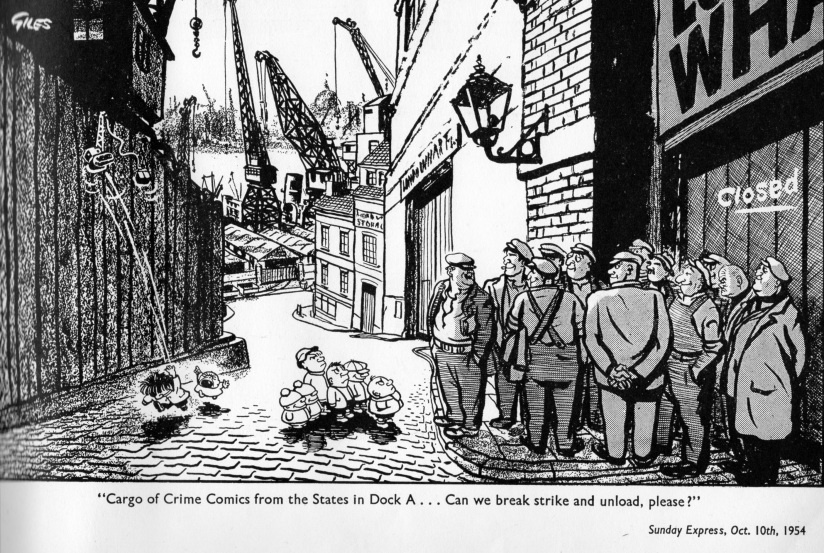
In light of Wertham’s book, in the States the baleful eye of the Senate Judiciary Committee moved away from communist infiltration and towards comic books. The Senate Subcommittee to Investigate Juvenile Delinquency was reconvened in 1953, chaired by Republican Senator Robert C. Hendrickson, and with a wonderful sense of drama Wertham and his arch nemesis, Bill Gaines, were called to testify on the same day (April 21, 1954). Testimony was filmed and broadcast. Wertham was used to public speaking, and had an academic’s arrogance combined with a flair for showmanship: ‘I think Hitler was a beginner compared to the comic book industry’ he told the committee, who leant a deferential and sympathetic ear (qtd. in Benton, 45). Gaines, an NYU literature graduate, a prolific writer and a highly successful publisher, was treated like a pornographer. He was overweight and nervous, and did not look good on television. Despite his manners and intellect, Gaines was oratorically out of his depth with experienced politicians like Hendrickson and Kefauver, and rattled by an accusation of racism from Wertham (EC’s agenda was quite clearly liberal, often publishing stories that challenged racism and segregation). It is difficult not to interpret these hearings, as does the historian John Springhall, in the context of McCarthyism, the committee representing a Cold War hegemony with a disdain for dissenting popular culture (Springhall, 121).
Despite being doomed before he took the stand, Gaines stood his ground as a creative practitioner in a free market, citing Judge Woolsey’s repeal of the ban on Joyce’s Ulysses, and explaining genre, narrative and graphic devices to Ivy League politicians that despised popular culture, and the subversive anti-realism of both Modernism and the Gothic. It was a case of Art versus Ideology, and the content of Gaines’ publications left his flank very exposed. The senators, like Wertham, read his comics with an appalled literalism, with no sense of critical irony or understanding of genre and context. A Mickey Spillane parody in EC’s satirical publication Panic (a forerunner of Mad), ‘My Gun is the Jury,’ was, for example, taken at face value as ‘utter perversion’ (Springhall, 138). It was too soon for a postmodern perspective, and ‘horror’ fiction was not viewed in the context of ‘Gothic literature’ but in terms of ‘bad taste,’ while stories such as ‘Foul Play,’ which deconstructed the sacred institution of baseball, ‘The Orphan,’ which challenged the cult of domesticity, and the satire on McCarthy and Wertham, ‘Are You a Red Dupe?’ were clearly an assault on core American values.
Although it is a tempting argument, the subcommittee was not, however, ‘McCarthyist,’ neither were members convinced by Wertham. The cross-examination was, instead, based around the concept of ‘taste,’ a term recklessly introduced by Gaines. Senator Kefauver pounced upon this term and asked him to explain a Johnny Craig cover illustration in this context: ‘This seems to be a man with a bloody axe holding a woman’s head up which has been severed from her body. Do you think that is in good taste?’ Gaines replied that he did, ‘for the cover of a horror comic’ (qtd. in Springhall, 138 – 139).
Gaines was fighting on two fronts. Wertham’s ‘effects theory’ reflected a common bourgeois fear of working class youth, framed by an essentially Christian appeal for the moral protection of ‘innocence’; the presumed prelapsarian state of children reflecting a wider cultural desire for Grace, a fear of corruption, and the familiar scapegoating of new media and popular narratives. The Seduction of the Innocent therefore deployed the same implicit causal arguments as, for example, the New York Society for the Suppression of Vice, and the aforementioned critics of the Newgate novel in the nineteenth century. In addition to Wertham’s thesis, Gaines was also debating Kefauver on the nature of cultural value. Kefauver’s interpretation of ‘good’ and ‘bad’ taste, therefore, indicated a hierarchical discrimination in which Gaines’ medium was rejected as juvenile (rather than adult and literary), and aesthetically illegitimate. John Springhall reads the ‘taste’ argument as ‘a symbolic weapon in the struggle for ideological domination, between established cultural arbiters and a new generation of commercial harbingers’ (Springhall, 139). The next day the press took Gaines apart.
Whether or not comics contributed to juvenile delinquency was not proven, in fact the subcommittee’s interim report of 1955 rejected Wertham’s monocausal model. (Wertham went on to campaign against violence on television.) Nonetheless, it concluded that ‘this nation cannot afford the calculated risk involved in the continuing mass dissemination of crime and horror comics to its children’ (qtd. in Springhall, 139). Censorship would have been a violation of the First Amendment, but the message to the industry from government was clearly expressed:
The subcommittee feels that the publishers of children’s comic books cannot discharge their responsibility to the Nation’s youth by merely discontinuing the publication of a few individual titles. It can be fully discharged only as they seek and support ways and means of insuring that the industry’s product permanently measures up to its standards of morality and decency which American parents have the right to expect (qtd. in Benton, 47).
The intimidated industry chose self-regulation. In an echo of the ACMP, the Comics Magazine Association of America was founded in September 1954, with editorial standards to be monitored by the independent Comics Code Authority, with New York Juvenile Court Judge Charles F. Murphy acting as commissioner. The ‘Code’ was published the following month. ‘General Standards for Editorial Matter’ (Parts A to C) included:
- Respected institutions shall never be presented in such a way as to create disrespect for established authority.
- Romance stories shall emphasise the value of the home and the sanctity of marriage.
- All scenes of horror, excessive bloodshed, gory or gruesome crimes, depravity, lust, sadism, [and] masochism shall not be permitted.
- Scenes dealing with, or instruments associated with walking dead, torture, vampires and vampirism, ghouls, cannibalism, and werewolfism are prohibited.
- Divorce shall not be treated humorously nor represented as desirable … The treatment of love-romance stories shall emphasise the value of the home and the sanctity of marriage.
- In every instance good shall triumph over evil … evil shall be published only where the intent is to illustrate a moral issue (Comics Code Authority, 1954).
Comics were vetted by the Authority, and were rewarded with a seal of approval. The injunctions that ‘Restraint in the use of the word “crime” in titles or sub-titles shall be exercised,’ and ‘No comic magazine shall use the word horror or terror in its title’ killed off the majority of the EC catalogue. Gaines attempted a ‘New Direction’ but wholesalers and retailers refused to handle EC titles, with the exception of the popular and lucrative Mad, which was exempt from the Code because of its format as a magazine rather than a comic book. The final EC comic was the February 1956 edition of Incredible Science Fiction, which included a civil rights allegory by Feldstein about a black astronaut called ‘Judgement Day.’ Murphy initially rejected the story because of the beads of sweat on the astronaut’s brow. Mad, however, now published by DC, continues to thrive to this day.
Although mainstream American comics were now effectively G-rated by a rigorously conservative manifesto, the transgressive graphic and narrative sophistication of EC was a clear intertextual influence on the next generation. For the counter-cultural and revolutionary ‘underground’ comics of the 1960s, EC was emblematic of the artistic struggle against censorship and hegemony. Ron Turner, for example, re-created Weird Science covers for his Slow Death ‘True War Tales,’ protesting the Vietnam War and South African apartheid.

A new generation of independent film-makers were also pursuing horror as cultural critique, while abandoning the gothic revivals of Hammer and American International. George A. Romero’s savage satire on segregation and consumerism, Night of the Living Dead (1968), ignores the traditional, post-colonial ‘zombie’ archetype in favour of the EC model. ‘The ECs influenced me greatly,’ Romero has admitted, continuing:
I think a great part of my aesthetics in the genre was born out of EC rather than movies. Horror movies, when I was in my formative years, were generally bad. The effects sucked. The ECs on the other hand, were nitty-gritty, there was a lot going on in each frame, the stories were great, and the effects were sensational! (qtd. in Gagne, 126).
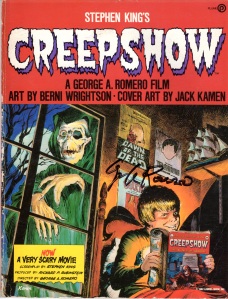
Romero also crossed the Johnny Craig story ‘Frozen Assets’ with an adaptation of Poe’s ‘Facts in the Case of M. Valdemar’ in Two Evil Eyes (1990), and collaborated with Stephen King on the EC-inspired anthology Creepshow (1982). Replicating an EC comic on screen was not a new idea. Amicus Productions made a series of EC inspired movies between 1964 and 1973, including the direct adaptations Tales from The Crypt (1972), and The Vault of Horror (1973). (Ralph Richardson played the Crypt Keeper.) Robert Bloch wrote the anthology Asylum for Amicus in 1972, and his novel of 1960, Psycho (and Hitchcock’s seismic adaptation), with its crime-to-gothic plot, slightly seedy protagonists, and motel hell scenario, is clearly in the EC mode. 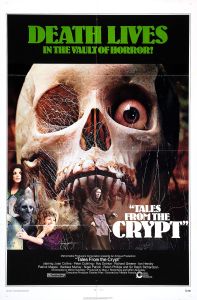
Stephen King has also acknowledged his debt to EC, writing that ‘As a kid, I cut my teeth on William Gaines horror comics.’ EC comics, writes King, ‘sum up for me the epitome of horror, that emotion of fear that underlies terror, an emotion which is slightly less fine, because it is not entirely of the mind. Horror also invites a physical reaction by showing us something which is physically wrong’ (King, 36). In his analysis of American Gothic, Danse Macabre (1982), King cites Gaines alongside Poe in terms of cultural significance. King also used the EC device of placing gothic archetypes in a contemporary setting, his second novel Salem’s Lot (1975), a kind of suburban Nosferatu, achieving with vampires what Hammer had failed to do in Dracula: A.D. 1972 (1972). Salem’s Lot was directed for television by Tobe Hooper in 1979, depicting vampires more like EC zombies than the prevailing Romantic stereotype which seemed suddenly so dated in John Badham’s film version of Dracula, which was released the same year.
Hooper is the quintessential heir to the EC aesthetic, in particular the work of Jack Davis. ‘I started reading [EC comics] when I was about seven,’ he told Cinefantastique in 1977:
They were absolutely frightening, unbelievably gruesome. And they were packed with the most unspeakably horrible monsters and fiends, most of which specialised in mutilation … I loved them. They were not in any way based on logic. To enjoy them you had to accept that there was a bogey man out there … Since I started reading these comics when I was young and impressionable, their overall feeling stayed with me. I’d say they were the single most important influence on The Texas Chainsaw Massacre. A lot of their mood went into the film (qtd. in Jaworzyn, 30).
In concept, character and controversy, Hooper’s meat movie masterpiece was pure EC, and his next movie, Death Trap (AKA Eaten Alive, 1976), was based on a story by Jack Davis called ‘Country Clubbing’ (Haunt of Fear 23, 1954). Hooper lit from a comic book palette, while his vérité style recalled the intimate perspective of EC narratives, as did his relentless parodies of the American family. There was also a common preoccupation with cannibalism, necrophilia and putrefaction. In Poltergeist (1982), Hooper blended the Twilight Zone story ‘Little Girl Lost’ with the Vault of Horror story ‘Graft in Concrete’ (again by Jack Davis, from Vault of Horror 26, 1952). Tales from the Crypt finally returned with a vengeance on HBO in 1989, bringing many of the original Gaines, Feldstein and Davis stories to the small screen. The show ran until 1996, comprising 93 episodes across seven seasons. Tobe Hooper directed the episode ‘Dead Wait’ in 1991. In, perhaps, the ultimate tribute, The Simpsons’ EC-inspired ‘Treehouse of Horror’ specials have aired every year since October 1990, and are as much a part of American Halloween tradition as Jack O’Lanterns and trick or treating.
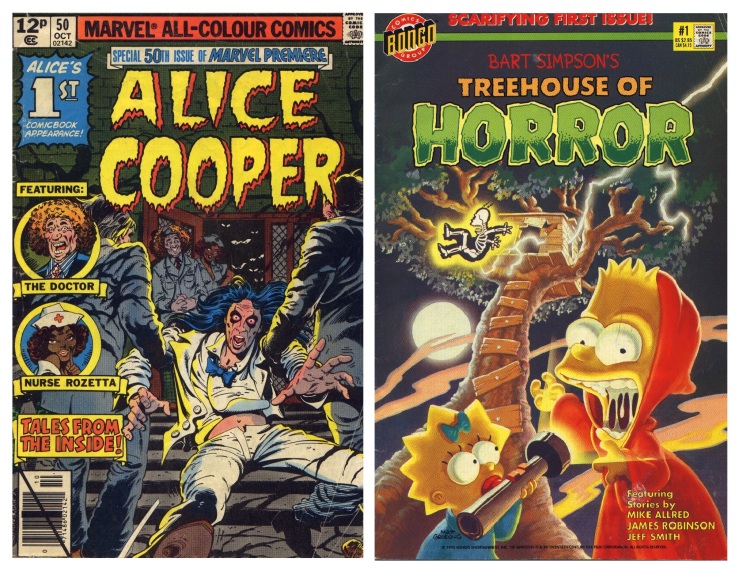 In rock ’n’ roll, meanwhile, the EC influence can also be seen in Alice Cooper (whose 1978 album From the Inside was accompanied by an EC-style comic produced by Marvel), The Cramps, Michael Jackson’s Thriller and, more recently, in the films of the Rob Zombie, whose hyper-real homage to Hooper and EC, House of 1000 Corpses (2003), is framed by a scary clown who addresses the viewer directly from the diegetic world of the narrative: ‘Howdy Folks! Do you like blood, violence, freaks of nature? Then come on down to Captain Spaulding’s Museum of Monsters and Madmen…’ (The humour is encoded in the reference to Groucho Marx’s character in the 1930 film Animal Crackers.) Not getting the joke, Universal delayed release for almost four years, and Zombie, along with Eli Roth, the writer/director of Hostel, had his work labelled ‘Torture Porn’ by David Edelstein, the chief film critic of New York Magazine. Zombie’s upcoming movie 31 would seem to be a continuation of the cinematic project he began with House of 1000 Corpses, and he has likened it to The Devil’s Rejects, the sequel to his first movie (Miska, 2015).
In rock ’n’ roll, meanwhile, the EC influence can also be seen in Alice Cooper (whose 1978 album From the Inside was accompanied by an EC-style comic produced by Marvel), The Cramps, Michael Jackson’s Thriller and, more recently, in the films of the Rob Zombie, whose hyper-real homage to Hooper and EC, House of 1000 Corpses (2003), is framed by a scary clown who addresses the viewer directly from the diegetic world of the narrative: ‘Howdy Folks! Do you like blood, violence, freaks of nature? Then come on down to Captain Spaulding’s Museum of Monsters and Madmen…’ (The humour is encoded in the reference to Groucho Marx’s character in the 1930 film Animal Crackers.) Not getting the joke, Universal delayed release for almost four years, and Zombie, along with Eli Roth, the writer/director of Hostel, had his work labelled ‘Torture Porn’ by David Edelstein, the chief film critic of New York Magazine. Zombie’s upcoming movie 31 would seem to be a continuation of the cinematic project he began with House of 1000 Corpses, and he has likened it to The Devil’s Rejects, the sequel to his first movie (Miska, 2015).
In contemporary comics, the present heir to the EC crown in terms of both style and impact is almost certainly The Walking Dead from Image Comics, written by Robert Kirkman and illustrated by Tony Moore and Charlie Adlard. The on-going series pays its respects in issue 64 by directly referencing the final panel from Jack Davis’ story ‘T’aint the Meat, It’s the Humanity’ (Tales from the Crypt 32, 1952). AMC’s TV adaptation of The Walking Dead has recently gained the highest total viewership of any series in cable television history (Bibel, 2015).
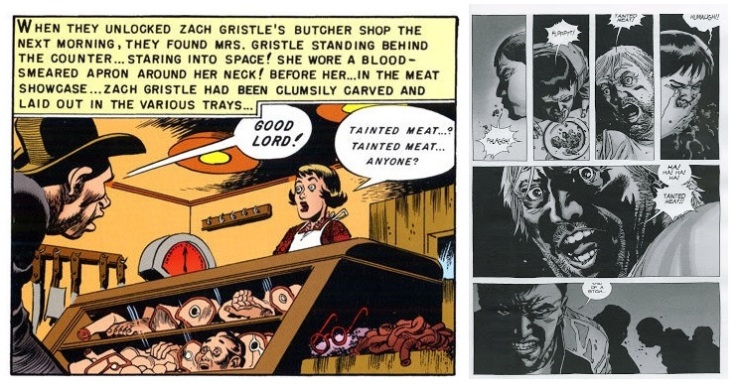
A lot has changed since Dr. Wertham took out EC, and a lot has stayed the same. Echoes of his thesis can still be heard, for example, in the UK ‘Video Nasties’ debate, inaugurated when the Conservative MP Graham Bright – supported by the Daily Mail, the police and a coalition of moral interest groups including Mary Whitehouse’s National Viewers’ and Listeners’ Association, the NSPCC, the Order of Christian Unity, and the Nationwide Festival of Light – sponsored a private members bill to outlaw American horror films on VHS. This led to the Video Recordings Act of 1984 and cuts to cult horror movies that left nothing but bland, incoherent plots and a lot of bad acting, while several iconic titles – such as The Texas Chainsaw Massacre and its sequels – were added to the ‘Obscene Publications’ list. The debate re-surfaced in the UK after the horrific murder of James Bulger in 1993 when, in his summing up of the trial of the schoolboy killers, Robert Thompson and John Venables, Mr. Justice Morland added the caveat ‘I suspect that exposure to violent video films may in part be an explanation,’ it being widely and erroneously reported in the press that the boys had been influenced by Child’s Play III. In support of his proposed amendment to the Criminal Justice Bill to restrict the certification of violent videos, Liberal Democrat MP David Alton commissioned a study by Elizabeth Newson, Professor of Developmental Psychology at the University of Nottingham. Her report ‘Video Violence and the Protection of Children’ was published in April 1994, and although Newson did not prove a clear, causal connection between fantasy and fact, the tabloid press took it as read anyway, and the British Board of Film Classification was required to take the concept of ‘psychological harm’ into account after the Criminal Justice Act was passed later in the year (5). At the end of the decade, in the US, the psychologist David Grossman gained much popular support for his argument that violence in television, movies and video games contributed to real-life violence by a process of training and desensitisation similar to combat experience. In the tradition of Wertham, his book was emotively entitled Stop Teaching Our Kids to Kill (1999).
The critical debate around ‘Torture Porn’ was somewhat more sophisticated, with Kira Cochrane of the Guardian viewing it as violently misogynist (Cochrane 2007), while David Edelstein likened the audience to self-harmers (Edelstein 2006). The influential and controversial horror blogger Curt Purcell has in the past lamented the loss of ‘subtle horror’ (2011), while in Cinefantastique, Steve Biodrowski dismissed such films as an ‘escapist sideshow that pretends to confront its audience with “realistic” horror while actually dodging reality’ (Biodrowski 2008). On his blog ‘Gospel of the Living Dead,’ meanwhile, Professor Kim Paffenroth has drawn some persuasive comparisons between contemporary and graphic horror and the respectable and aesthetically justifiable violence of Sophocles and Shakespeare (Paffenroth 2011).
Yet this debate is now in many ways redundant, as evidenced by the mainstream success of TV shows like The Walking Dead, American Horror Story, Z Nation, and Ash vs. The Evil Dead, to name but a few, and the increasing proliferation of violent horror movies in not only the independent sector but in the Hollywood mainstream. World War Z, for example, cost an estimated $120 million (well over a thousand times more than the budget of the original Night of the Living Dead). The public’s demand for zombies appears insatiable; extreme cinema is now just another genre, and films banned a generation ago are now regularly broadcast on television. TV ‘police procedurals,’ meanwhile, routinely depict death and decomposition with an EC-like verisimilitude that would have been unacceptable to the FCC, the MPAA and, indeed, the Comics Code a decade ago. But although shows like Bones, NCIS, and the CSI franchise offer a positive portrayal of law enforcement alongside the physical realism that special effects and a relaxation of censorship allow, the EC legacy tells a different tale, of a more random, human horror in which there is rarely reason, let alone an identifiable moral centre, as explored in the expedient ethics of survival in The Walking Dead. The single revenant, meanwhile, has become the unstoppable, apocalyptic hoard; a dark, repeating death-dream of a world in which the taboo of showing corpses on the TV news has long since become the norm, and real people are tortured, beheaded and burned alive online, while the rest of us look on or look away, equally helpless and appalled. Thus reminded of the true nature of the human condition, the worst excesses of film and fiction are no more than a fairy tale, or, more darkly, a legitimate cultural response. And you can’t censor real life. All you can do – like Bill Gaines, his team, their horror hosts and their imitators – is gaze into the abyss and laugh. Tales from the Crypt are everywhere these days…
NOTES
- For a detailed analysis of Superman and his creators in this context see Ivy Garlitz, ‘Evocations of Immigration in Popular Culture: The Multiple Identities of Superman,’ Comics Forum 23, Summer 2002; and ‘Themes of Immigration in Superman,’ Comics Forum 24, Autumn 2002.
- In an astute piece of reverse engineering and intertextual doubling, Johnny Craig introduced a Vampira-like character called ‘Drusilla’ to Haunt of Fear 37, although the title was cancelled before she was developed as a fourth host. See Ryan B, ‘Spotlight on Drusilla, The Lost GhouLunatic,’ (2013). Horror Hosts and Creature Features. Available from: http://www.horrorhostmagazine.com/tag/drusilla/
- See Stephen Carver, ‘Tales of Terror from the House of Blackwood,’ (2016). Ainsworth & Friends: Essays on 19th Century Literature & The Gothic. Available from: https://ainsworthandfriends.wordpress.com/2016/02/11/tales-of-terror-from-the-house-of-blackwood/
- See Stephen Carver, ‘Writing the Underworld: Ainsworth’s Jack Sheppard and the Newgate Controversy’ (Part 3), (2013). Ainsworth & Friends: Essays on 19th Century Literature & The Gothic. Available from: https://ainsworthandfriends.wordpress.com/2013/02/28/writing-the-underworld-ainsworths-jack-sheppard-and-the-newgate-controversy-part-three/
- See Martin Barker and Julian Petley, eds, Ill Effects: The Media/Violence Debate London: Routledge, 1997.
- See Barker, A Haunt of Fears: The Strange History of the British Horror Comics Campaign. London: Pluto, 1984.
WORKS CITED
Barker, Martin. (1984). A Haunt of Fears: The Strange History of the British Horror Comics Campaign. London: Pluto.
Barker, Martin and Petley, Julian, eds. (1997). Ill Effects: The Media/Violence Debate London: Routledge.
Benton, Mike. (1991). The Illustrated History of Horror Comics. Dallas: Taylor Publishing.
Bibel, Sara. (2015). ‘The Walking Dead Season 5 Finale is Highest Rated Finale in Series History, Garnering 15.8 Million Viewers.’ TV by the Numbers. Available from: http://tvbythenumbers.zap2it.com/2015/03/30/the-walking-dead-season-5-finale-is-highest-rated-finale-in-series-history-garnering-15-8-million-viewers/381342/ (Accessed February 13 2015).
Biodrowski, Steve. (2008). ‘Cybersearching: Torture Porn Debate.’ Available from: http://cinefantastiqueonline.com/2008/05/cybersurfing-torture-porn-debate/ (Accessed April 09 2011).
Brady, Thomas F. (1949). ‘Hollywood Digest’ New York Times December 2. In Anon, ‘The Hollywood Studio System, 1946-1949’ Available from: http://encyclopedia.jrank.org/articles/pages/2943/The-Hollywood-Studio-System-1946-1949.html (Accessed March 21, 2011).
Cochrane, Kira. ‘For your entertainment.’ The Guardian. May 1, 2007, pp. 4 – 7.
Comics Code Authority. (1954). ‘Code of the Comics Magazine Association of America, Inc’ New York.
Edelstein, David. (2006). ‘Now Playing at Your Local Multiplex: Torture Porn.’ The New York Magazine. Available from: http://nymag.com/movies/features/15622/ (Accessed April 09 2011).
Frank, J. (1942). ‘Let’s Look at the Comics.’ Child Study, 19(3), 76 – 77, 90 – 91. —. (1943). ‘The role of comic strips and comic books in child life.’ Supplementary Educational Monographs, 57, 158 – 162. —. (1944). ‘What’s in the Comics?’ Journal of Educational Sociology, 18(4), 214 – 222. —. (1949). ‘Some Questions and Answers for Teachers and Parents.’ Journal of Educational Sociology, 23(4), 206 – 214.
Gabilliet, Jean-Paul. (2005). Of Comics and Men: A Cultural History of American Comic Books. Jackson: University Press of Mississippi.
Gagne, Paul R. (1987). The Zombies that Ate Pittsburgh: The Films of George A. Romero. New York: Dodd, Mead & Co.
Gifford, Dennis. (1991). Mad Doctors, Monsters and Mummies. London: Blossom.
Grossman, David. (1999). Stop Teaching Our Kids to Kill: A Call to Action against TV, Movie and Video Game Violence. New York: Crown.
Jaworzyn, Stefan. (2003). The Texas Chainsaw Massacre Companion. London: Titan.
King, Stephen. (1982). Danse Macabre. London: Futura.
Krensky, Stephen. (2008). Comic Book Century: The History of American Comic Books. Minneapolis: Twenty-First Century Books.
Miska, Brad (as ‘MrDisgusting’). (2015). ‘Rob Zombie Screens 31 and Compares it to The Devil’s Rejects.’ Bloody Disgusting. Available from: http://bloody-disgusting.com/images/3362398/rob-zombie-screens-31-and-compares-it-to-the-devils-rejects/ (Accessed February 13 2015).
Lehman, H.C. and Witty, P.A. (1927). ‘The compensatory function of the Sunday “funny paper.”’ Journal of Applied Psychology 11(3) 202 – 211.
Paffenroth, Kim. (2011). ‘Gospel of the Living Dead.’ Available from: http://gotld.blogspot.com/ (Accessed April 09 2011).
Purcell, Curt. (2011). ‘The Groovy Age of Horror.’ Available from: http://groovyageofhorror.blogspot.com/ (Accessed April 09 2011).
Sabin, Roger. (1993). Adult Comics. London: Routledge.
Sage, Victor. (2004). Le Fanu’s Gothic: The Rhetoric of Darkness. London: Palgrave Macmillan.
Springhall, John. (1998). Youth, Popular Culture and Moral Panics. London: MacMillan.
Thorndike, R. L. (1941). Words and the Comics. Journal of Experimental Education, 10(2), 110 – 113.
Warshow, Robert S. (1954). ‘The Study of Man: Paul, the Horror Comics, and Dr. Wertham.’ Commentary. Available from: http://www.commentarymagazine.com/article/the-study-of-man-paul-the-horror-comics-and-dr-wertham/ (Accessed April 10 2011).
Wertham, Fredric. (1955). Seduction of the Innocent. London: Museum Press.
Witty, P.A. (1941). ‘Children’s Interest in the Comics.’ Journal of Experimental Education, 10(2), 100 – 104. Witty, P.A. (1941). ‘Reading the Comics—A Comparative Study.’ Journal of Experimental Education, 10(2), 105 –109.

